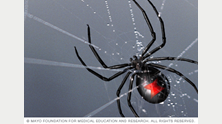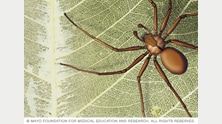You've recently included spiders in your plotline. Can you tell me why?
Unlike other creatures that have the potential to harm humans, poisonous spiders can move about silently and unobserved in the dark. They can scurry under the smallest opening at the bottom of a closed door or window. They can climb up walls and disappear into a sliver of a crack. When chased, they can scoot under furniture, appliances, clothing, and even, a child’s toy. The possibilities are endless. They can easily join you in bed without being noticed. Only a light sleeper could feel one crawling on their bare skin. And, if it is a poisonous spider, can strike without warning.
William Hazlitt’s (1778-1830) essay “On the Pleasure of Hating” (c. 1826) began by describing the movement of a spider: “There is a spider crawling along the matted floor … he runs with heedless, hurried haste, he hobbles awkwardly towards me, he stops—he sees the giant shadow before him, and, at a loss whether to retreat or proceed, meditates his huge foe—but as I do not start up or seize upon the struggling caitiff, as he would upon a helpless fly within his toils, he takes heart and ventures on, with mingled cunning, impudence and fear. … I bear the creature no ill-will, but still I hate the very sight of it.” Even today, that same sentiment exists—most people hate the very sight of spiders. The feeling is often intertwined with fear.
You see, I love spiders. They do so much good.
People rarely consider the benefits of having spiders on our planet. Spiders help control the insect population. Without them, insects would flourish into pest proportions. Yet, often when a spider is spotted it is crushed without remorse. Sara Jones, the protagonist in “The Tegen Cave,” appreciates and loves the delicate creatures. She attempts to protect the poisonous spiders that appear in her bed, and mourns when she fears some have perished.
The spiders in my novel are mutant hobo spiders, Tegenaria agrestis. That name is the basis for the novel’s title, “The Tegen Cave.” Tegenaria agrestis is one of a small number of spider species whose bites are painful and medically significant. The venom is so strong it sometimes causes necrosis, the death of cells and tissues around the injected area of the body.
Hobo spiders are known to be aggressive and vary significantly in appearance. A microscopic examination by an arachnologist, or someone knowledgeable in that field, is required for positive identification. Since Sara has been exposed to spiders all her life, she suspects the arachnids in the hotel are hobo spiders, but she can’t confirm that identity without a close examination under a microscope.
I bet this was a cool topic to research!
In doing preliminary research for my novel, I discovered some fascinating facts about various spider families’ predator abilities. Ordgarius magnificus, the magnificent spider, sets silk traps with a pheromone that mimics a moth’s. Believing a female moth is close by, male moths are lured to the trap. The spider subdues the pursuer, and the moth becomes a nutritious meal. Ant spiders of the Zodarlidae family imitate ants by using their front legs to mimic antennae. A trusting ant is soon devoured. Female flower crab spiders, Misumena vatia, can blend with flowers by changing their colors from white to yellow. They spread their sticky web and wait patiently for pollinators.
In my dark fantasy I wanted a creature that had the ability to enter a room undetected and, while there, poison targeted humans. After they accomplished that task, they needed the capacity to come when summoned along with some additional talents. The aggressive nature and toxicity of the hobo spider matched some of the desirable characteristics. Since no spider species possessed all the qualities, I expanded the hobo spiders’ skills and made them a mutant species in “The Tegen Cave.” Once targeted, there is no place you can go and hide from the deadly Tegen spiders.
In doing preliminary research for my novel, I discovered some fascinating facts about various spider families’ predator abilities. Ordgarius magnificus, the magnificent spider, sets silk traps with a pheromone that mimics a moth’s. Believing a female moth is close by, male moths are lured to the trap. The spider subdues the pursuer, and the moth becomes a nutritious meal. Ant spiders of the Zodarlidae family imitate ants by using their front legs to mimic antennae. A trusting ant is soon devoured. Female flower crab spiders, Misumena vatia, can blend with flowers by changing their colors from white to yellow. They spread their sticky web and wait patiently for pollinators.
In my dark fantasy I wanted a creature that had the ability to enter a room undetected and, while there, poison targeted humans. After they accomplished that task, they needed the capacity to come when summoned along with some additional talents. The aggressive nature and toxicity of the hobo spider matched some of the desirable characteristics. Since no spider species possessed all the qualities, I expanded the hobo spiders’ skills and made them a mutant species in “The Tegen Cave.” Once targeted, there is no place you can go and hide from the deadly Tegen spiders.
Lovely! Here's what can help your character:
From the Mayo Clinic page on Spider Bite First-Aid:
Most spider bites cause only minor injury. A few spiders can be dangerous. In the United States, these include the black widow spider and the brown recluse spider.
Seek emergency care immediately if:
- You were bitten by a black widow or brown recluse spider
- You are unsure whether the bite was from a poisonous spider
- You have severe pain, abdominal cramping or a growing ulcer at the bite site
- The person who was bitten isn't breathing
To take care of a spider bite:
- Clean the wound. Use mild soap and water and apply an antibiotic ointment.
- Apply a cool compress. Use a cloth dampened with cold water or filled with ice. This helps reduce pain and swelling. If the bite is on an arm or leg, elevate it.
- Take an over-the-counter pain medication if needed. If the wound is itchy, an antihistamine (Benadryl, Chlor-Trimeton, others) may help.
Your doctor may recommend a tetanus booster shot if you haven't had one in the last five years.
Black widow spider
You can usually identify a black widow spider by the hourglass marking on its belly. In the United States, this spider is more common in the South.
Signs and symptoms of a black widow spider bite may include:
- At first, slight swelling and faint red marks
- Intense pain and stiffness
- Severe abdominal pain or cramping
- Chills, fever and nausea
Brown recluse spider
The brown recluse spider has a violin-shaped marking on its back, but this mark can be hard to see. In the United States, its range is central and southern states.
Signs and symptoms of a brown recluse spider bite vary but may include:
- At first, a mild pain
- Redness and intense pain
- A deep blue or purple area around the bite, which may develop a red ring around it
Read Inge-Lise's book in the Dead & Gone Serial Killer anthology!






No comments:
Post a Comment